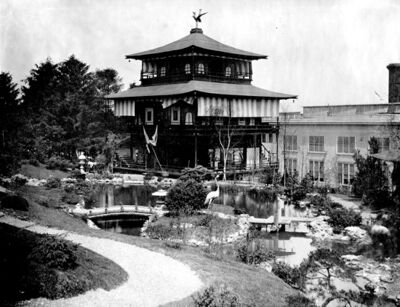Japan Garden
 | |
| Location | The Trail |
|---|---|
| No. of Buildings | 8 |
| Construction | |
| Construction Cost | $80,000 ($2.41 million in 2021) |
Japan's National Pavilion had seven large buildings and a number of small pagodas, built of native material by Japanese artisans. The pavilion occupied the space on the site of a beautiful hill west of Cascade Gardens and south of Machinery Palace.
Before the Fair
Description
The main pavilion was an ornate reproduction of the "Shishirvden," a palace at Tokyo, in which the Japanese Emperor granted audiences to his ministers of state. Other buildings, including the Commissioner's office, the Bellevue Pavilion, a Bazaar, a Kinkaku tea pavilion, a Formosa tea pavilion and a tea show building. Beautiful tiles and carvings were used in decorating all of the structures, and the furnishings were of the most elaborate and expensive designs. Along with the tiles, stone lanterns were brought over from Japan to make the exhibit as realistic as possible.
Sloping away from the central buildings were winding walks that flowed into an Oriental garden of great beauty. Hidden here and there in the foliage were pagodas, constructed by skilled Japanese artisans brought from the Far East.
Elaborate tea rituals (culture), as well as casual tea offerings were served by Japanese experts in certain pavilions inside some structures. In other buildings there were exhibits of tea specimens, and methods of tea production are demonstrated.
One corner of the pavilion was a bazaar, where visitors could buy all sorts of Japanese wares.
The observation garden was a strikingly beautiful area that was modeled from a Shogun residence in the 17th century. There miniature lakes blended with waterfalls and bridges to create a peace magnificence. 200-year old Bonsai trees were imported for this garden.
In the two tea houses, one could buy green tea, with a tea cake for 10 cents. Souvenir tea sets cost 40 cents.
After the Fair

In 1904, the Emperor Meiji of Japan honored Takamine with an unusual gift. The "Pine and Maple Palace" (Shofu-den), modelled after the Kyoto Imperial Coronation Palace of 1,300 years ago. This structure was given to Dr. Takamine in grateful recognition of his efforts to further friendly relations between Japan and the United States. He had the structure transported in sections from Missouri to his summer home in upstate New York, seventy-five miles north of New York City. In 1909, the structure served as a guest house for Prince Kuni Kuniyoshi and Princess Kuni of Japan, who were visiting the area. Although the property was sold in 1922, the reconstructed structure remained in its serene setting. In 2008, it still continues to be one of the undervalued tourist attractions of New York's Sullivan County, located at 36 Merriewold Road, Forestburgh, NY 12777.
